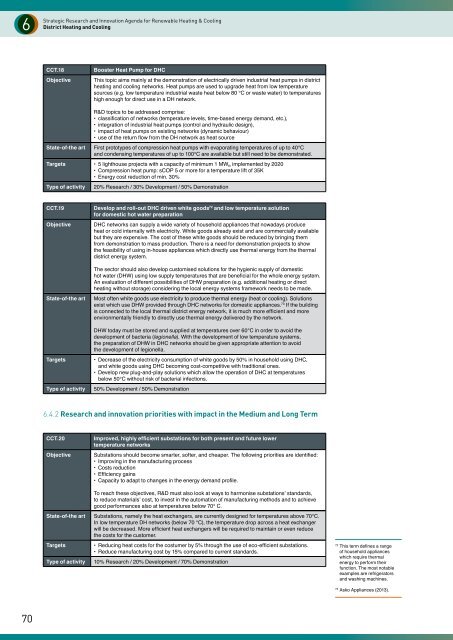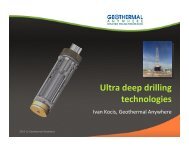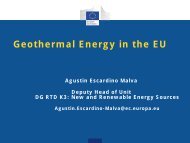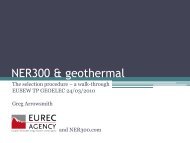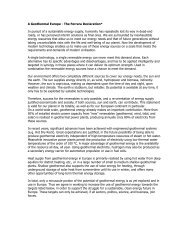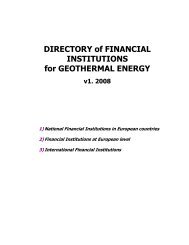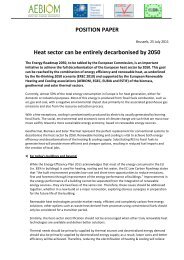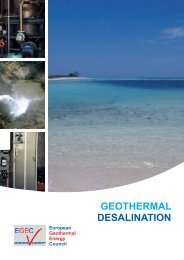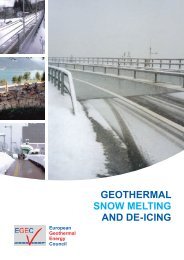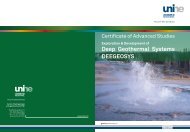Strategic Research and Innovation Agenda for Renewable ... - EGEC
Strategic Research and Innovation Agenda for Renewable ... - EGEC
Strategic Research and Innovation Agenda for Renewable ... - EGEC
Create successful ePaper yourself
Turn your PDF publications into a flip-book with our unique Google optimized e-Paper software.
6<strong>Strategic</strong> <strong>Research</strong> <strong>and</strong> <strong>Innovation</strong> <strong>Agenda</strong> <strong>for</strong> <strong>Renewable</strong> Heating & CoolingDistrict Heating <strong>and</strong> CoolingCCT.18ObjectiveBooster Heat Pump <strong>for</strong> DHCThis topic aims mainly at the demonstration of electrically driven industrial heat pumps in districtheating <strong>and</strong> cooling networks. Heat pumps are used to upgrade heat from low temperaturesources (e.g. low temperature industrial waste heat below 80 °C or waste water) to temperatureshigh enough <strong>for</strong> direct use in a DH network.R&D topics to be addressed comprise:• classification of networks (temperature levels, time-based energy dem<strong>and</strong>, etc.),• integration of industrial heat pumps (control <strong>and</strong> hydraulic design),• impact of heat pumps on existing networks (dynamic behaviour)• use of the return flow from the DH network as heat sourceState-of-the art First prototypes of compression heat pumps with evaporating temperatures of up to 40°C<strong>and</strong> condensing temperatures of up to 100°C are available but still need to be demonstrated.Targets • 5 lighthouse projects with a capacity of minimum 1 MW th implemented by 2020• Compression heat pump: sCOP 5 or more <strong>for</strong> a temperature lift of 35K• Energy cost reduction of min. 30%Type of activity20% <strong>Research</strong> / 30% Development / 50% DemonstrationCCT.19ObjectiveDevelop <strong>and</strong> roll-out DHC driven white goods 72 <strong>and</strong> low temperature solution<strong>for</strong> domestic hot water preparationDHC networks can supply a wide variety of household appliances that nowadays produceheat or cold internally with electricity. White goods already exist <strong>and</strong> are commercially availablebut they are expensive. The cost of these white goods should be reduced by bringing themfrom demonstration to mass production. There is a need <strong>for</strong> demonstration projects to showthe feasibility of using in-house appliances which directly use thermal energy from the thermaldistrict energy system.The sector should also develop customised solutions <strong>for</strong> the hygienic supply of domestichot water (DHW) using low supply temperatures that are beneficial <strong>for</strong> the whole energy system.An evaluation of different possibilities of DHW preparation (e.g. additional heating or directheating without storage) considering the local energy systems framework needs to be made.State-of-the artMost often white goods use electricity to produce thermal energy (heat or cooling). Solutionsexist which use DHW provided through DHC networks <strong>for</strong> domestic appliances. 73 If the buildingis connected to the local thermal district energy network, it is much more efficient <strong>and</strong> moreenvironmentally friendly to directly use thermal energy delivered by the network.DHW today must be stored <strong>and</strong> supplied at temperatures over 60°C in order to avoid thedevelopment of bacteria (legionella). With the development of low temperature systems,the preparation of DHW in DHC networks should be given appropriate attention to avoidthe development of legionella.TargetsType of activity• Decrease of the electricity consumption of white goods by 50% in household using DHC,<strong>and</strong> white goods using DHC becoming cost-competitive with traditional ones.• Develop new plug-<strong>and</strong>-play solutions which allow the operation of DHC at temperaturesbelow 50°C without risk of bacterial infections.50% Development / 50% Demonstration6.4.2 <strong>Research</strong> <strong>and</strong> innovation priorities with impact in the Medium <strong>and</strong> Long TermCCT.20ObjectiveImproved, highly efficient substations <strong>for</strong> both present <strong>and</strong> future lowertemperature networksSubstations should become smarter, softer, <strong>and</strong> cheaper. The following priorities are identified:• Improving in the manufacturing process• Costs reduction• Efficiency gains• Capacity to adapt to changes in the energy dem<strong>and</strong> profile.State-of-the artTargetsType of activityTo reach these objectives, R&D must also look at ways to harmonise substations’ st<strong>and</strong>ards,to reduce materials’ cost, to invest in the automation of manufacturing methods <strong>and</strong> to achievegood per<strong>for</strong>mances also at temperatures below 70° C.Substations, namely the heat exchangers, are currently designed <strong>for</strong> temperatures above 70°C.In low temperature DH networks (below 70 °C), the temperature drop across a heat exchangerwill be decreased. More efficient heat exchangers will be required to maintain or even reducethe costs <strong>for</strong> the customer.• Reducing heat costs <strong>for</strong> the costumer by 5% through the use of eco-efficient substations.• Reduce manufacturing cost by 15% compared to current st<strong>and</strong>ards.10% <strong>Research</strong> / 20% Development / 70% Demonstration72This term defines a rangeof household applianceswhich require thermalenergy to per<strong>for</strong>m theirfunction. The most notableexamples are refrigerators<strong>and</strong> washing machines.73Asko Appliances (2013).70


